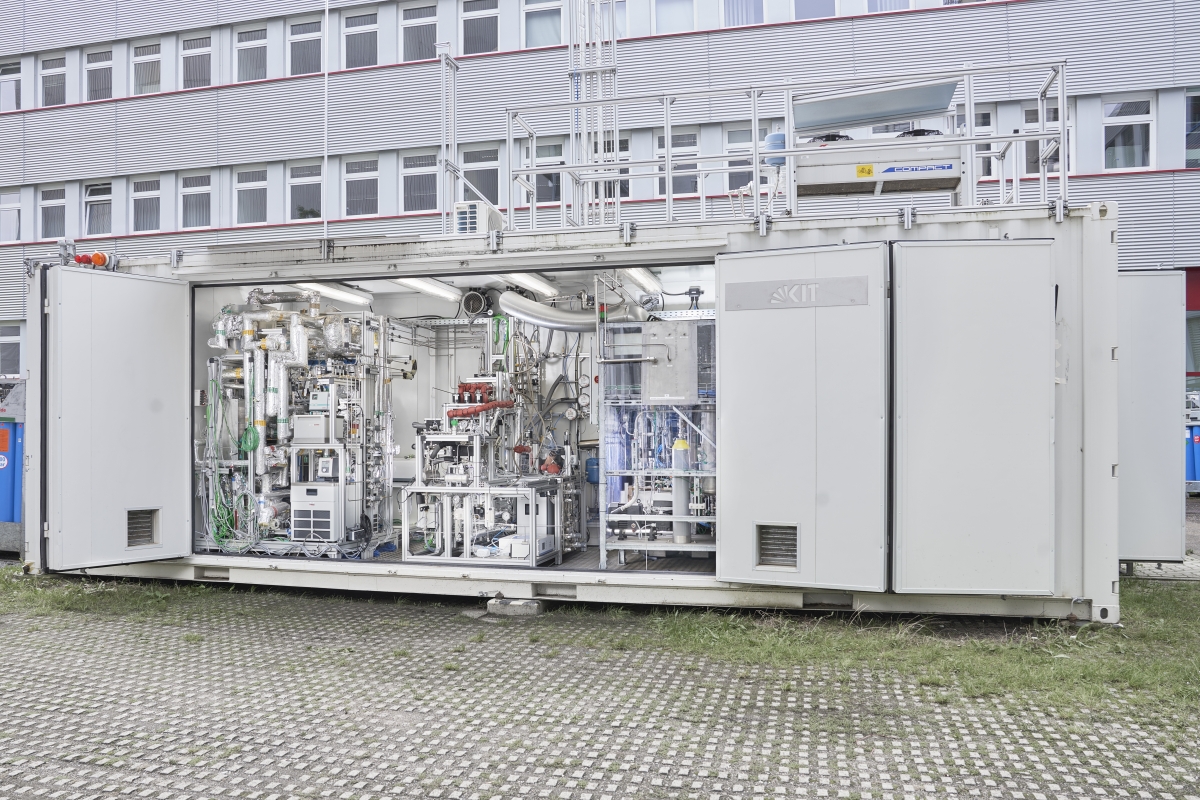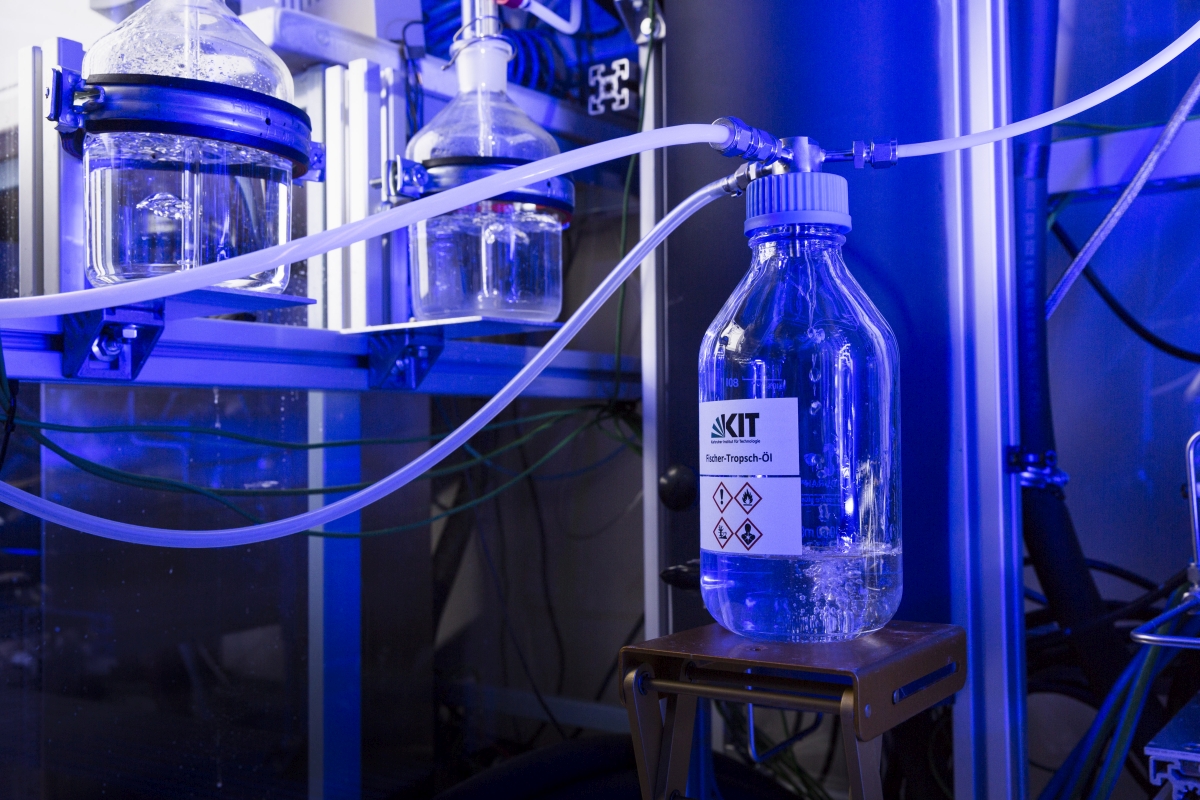Is Green Hydrogen the Petroleum of the Future?
A substantial number of experts expect green hydrogen produced from wind or solar energy to become something like a climate-neutral petroleum of the future. This view is shared by the German Federal Government that considers this energy carrier a key factor for a successful energy transition. Talking to Professor Roland Dittmeyer and Dr. Frank Graf, two renowned hydrogen researchers at KIT, lookKIT tried to get an assessment as to whether the smallest element in the periodic table will be able to meet the expectations that spurred national hydrogen strategies worldwide as well as in Germany.
Roland Dittmeyer is Head of KIT’s Institute for Micro Process Engineering (IMVT) and one of the researchers involved in the H2Mare hydrogen lead project funded by the German Federal Ministry of Education and Research (BMBF). Frank Graf heads the Gas Technology Group of the DVGW Research Center at the Engler-Bunte Institute (DVGW-EBI) of KIT. He also is coordinator of the GET H2 TransHyDE collaboration in the TransHyDE hydrogen lead project funded by BMBF.
lookKIT: Green hydrogen is said to be extremely versatile – such that it could take on the role of a universally usable key resource in climate policy for decarbonizing the global economy. Are these hopes justified?
Roland Dittmeyer: Only if we succeed in producing the huge quantities of hydrogen needed worldwide as “green hydrogen”, namely by using renewable resources.
Dr. Frank Graf: A current analysis by the Hydrogen Council, an international association of companies that aims at expediting the use of hydrogen technologies, predicts a global hydrogen-based energy demand of approximately 25,000 terawatt hours per year. We have developed a scenario according to which Germany alone will need about 700-800 terawatt hours by 2045.
Is it possible to produce that much in Germany?
Graf: About 40 percent of the required hydrogen can be produced by Germany on its own. The remainder will have to be imported. For this purpose, establishing a suitable infrastructure is indispensable. This infrastructure includes, in particular, a European network of pipelines and ships for the maritime transport of liquid hydrogen and its derivatives, such as methane, methanol, or ammonia.
But what about the expansion of the production capacities in the eligible export countries, which seems to be rather sluggish?
Graf: Renewable energies are advantageous in that we do not depend on particular countries or regions. Unlike petroleum or natural gas, hydrogen benefits from large potential capacities worldwide, which makes it easier to diversify the sources of supply. In theory, Europe could even rely completely on its own green hydrogen production capacities. However, this will certainly not be an option for cost reasons. Due to large production potentials, low production costs, and moderate distances, Europe is particularly interested in the Middle East and North Africa, the MENA region. There, infrastructures for natural gas are already available and can be used for green gases as well. These infrastructures include gas pipelines and liquefaction plants for natural gas. However, political risks are great in this region.
What are the challenges for smaller, decentralized facilities compared to those for centralized major plants, which can be coupled with large wind parks, for example?
Dittmeyer: Even smaller facilities operate in the megawatt range. Since these are needed in very large numbers, the research on how to achieve industrial series production of electrolyzers for the production of hydrogen is a critical issue. Big plants, in turn, produce energy in the gigawatt range, requiring production sites where large quantities of regenerative energy are available at low cost.
Graf: For large-scale hydrogen production, for example in the MENA region, the available megawatt-level electrolysis systems need to be coupled to provide industrial plants operating in the gigawatt range. Advancing the development of high-temperature co-electrolysis for the production of carbon monoxide-hydrogen mixtures is another important topic. Hydrocarbons synthesized in this way are suitable for the production of alternative fuels or for applications in the chemical industry. Besides, we will require many more electrolyzers to process surplus power, such as from solar energy production peaks, in smaller, decentralized facilities. Hydrogen electrolysis could thus contribute to the stabilization of the power grid.
What is the maximum degree of efficiency obtained by electrolysis?
Dittmeyer: With the classical processes, namely alkaline or proton-exchange membrane electrolysis, we obtain an efficiency of about 60 to 70%. The newer high-temperature steam electrolysis has an efficiency potential of more than 80%, provided that the steam is produced from waste heat. Electrolysis efficiency, however, is also a function of the load applied to the process. The efficiency decreases with increasing load.
Is hydrogen-based chemical buffering of energy a long-term or rather a short-term solution?
Graf: Seasonal storage of hydrogen over several weeks or even months in large underground storage systems is possible, as for natural gas. In view of stabilizing the local power supply, hydrogen could be fed to the gas distribution grid or be stored in spherical gas tanks so that it can be reconverted into electricity, when required.
Dittmeyer: Unlike electricity storage in batteries, hydrogen-based chemical energy storage is especially suitable for larger quantities and longer periods. While battery storage is relatively expensive, chemical storage is associated with bigger efficiency losses.
Is it possible to leverage the existing natural gas infrastructure for storage and transport?
Graf: Here, we must differentiate between hydrogen admixtures to natural gas or all-hydrogen networks. As regards the pipeline materials, 96 percent of our gas grids are compatible with hydrogen, but the whole periphery and the applications must also be considered. For example, what are the payment arrangements? While technical rules already exist for feeding hydrogen into the grid, this issue will gain importance in the coming years. Besides its storage capability, green hydrogen also plays a major role in the decarbonization of the chemical industry.
Dittmeyer: This is correct. Chemical process chains, such as the production of ammonia or ethylene, have so far been using gray hydrogen, which was obtained by the combustion of fossil fuels. These processes can of course be continued using green hydrogen.
And how can hydrogen contribute to mobility decarbonization?
Dittmeyer: Trains powered by hydrogen-based fuel cells are already operational. This makes sense in cases where it would be too expensive to electrify a particular railroad track. Trucks could also be powered by fuel cells using hydrogen. For passenger cars, the development of fuel cells compared to batteries is the decisive factor.
What about the climate neutral e-fuels obtained from hydrogen?
Dittmeyer: Policymakers restrict the use of e-fuels to specific applications, for example synthetic kerosene as aviation fuel. As a by-product, however, synthetic diesel is obtained, which could be used for commercial, construction, and agricultural vehicles. Even passenger cars could be powered by e-fuels. The point brought forward against these options is that the fully electric solution, which is more efficient, has ultimately been favored.
Doesn’t this violate the principle of technological openness? After all, the speed of decarbonization is an important factor as well.
Dittmeyer: Yes, but the depth of decarbonization also matters. The trick is to advance on both tracks. Policymakers are concerned the societal acceptance of battery-powered mobility might get undermined if they treat e-fuels as equivalent. This could result in the vehicle fleet turnover taking possibly longer than desired.
Graf: But even if the number of electric vehicles reaches 15 million in ten years’ time, there will still be 30 million fossil fuel-powered vehicles on the roads. This is why we will soon be forced to produce large quantities of synthetic fuels – not only for heavy trucks and for airplanes. We simply cannot wait until all vehicles will be electrified.
KIT participates in the H2Mare hydrogen lead project funded by the Federal government. This project investigates how the production of hydrogen can be coupled directly with the large offshore wind parks. What are the advantages?
Dittmeyer: The electrical connection of wind parks located far off the coast is expensive. If hydrogen can be produced offshore and then be pipelined to the coast, the transport costs are less than the costs for connecting the wind parks electrically. Moreover, coupling the electrolysis directly with the wind park is more efficient, requires less components, and avoids the costly onshore feeding of gigawatts of electrical energy into the grid. These advantages are countered by the expenditure of offshore operation: platform costs, maintenance at sea, automation of workflows and processes, or hardening against weather extremes. This is what we are investigating in this project.
Stefan Fuchs, January 18, 2023



